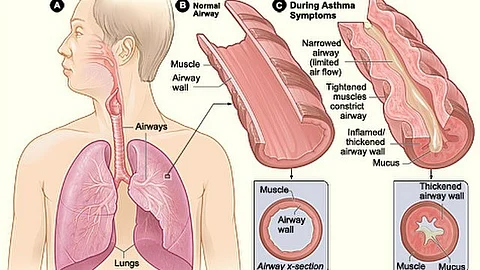The airway, breathing, circulation, disability, and exposure should be assessed. If the patient is conscious, they should be positioned upright and given a bronchodilating agent to inhale. It can be repeated if necessary. If the patient cannot use the inhaler effectively, the medication should be administered using a spacer device. Oxygen via a face mask should be administered. If there is no improvement, the patient's condition deteriorates, epinephrine is injected subcutaneously. If there is no improvement or the asthma attack is severe, call for emergency medical assistance. Optimal oxygen levels should be maintained until the patient's wheezing subsides or medical assistance arrives. If the patient loses consciousness, cardiopulmonary resuscitation (CPR) should be initiated.
In case of foreign body inhalation, symptoms of respiratory distress, such as choking, wheezing, and difficulty breathing, accompanied by the rapid onset of accessory muscle use, are clear indicators that immediate action is needed. At first, the patient should be asked to sit up straight and cough vigorously. If a severe cough does not alleviate the obstruction, the Heimlich maneuver (a technique used for people who are choking) should be performed. If this proves ineffective, the patient must be taken to the nearest emergency room immediately. While waiting for transfer, the dentist should take critical measures, including performing a cricothyrotomy to open the airway if necessary.
In conclusion, providing dental care for asthmatic patients requires a thorough understanding of their unique needs and potential complications. Effective communication and careful planning are essential to minimize stress and prevent asthma attacks during dental procedures. Pre-treatment assessments should include a detailed medical history and consideration of any asthma medications the patient is using. Preventive measures and prompt response to any signs of respiratory distress are crucial to ensure patient safety. By implementing these strategies, dental professionals can provide safe and effective care for asthmatic patients.
References
Asthma [Internet]. [cited 2024 May 14]. Available from: https://www.who.int/news-room/fact-sheets/detail/asthma.
Gani F, Caminati M, Bellavia F, Baroso A, Faccioni P, Pancera P, et al. Oral health in asthmatic patients: a review. Clin Mol Allergy [Internet]. 2020 [cited 2024 May 15]; 18:22. Available from: https://www.ncbi.nlm.nih.gov/pmc/articles/PMC7648282/.
Harrington N, Prado N, Barry S. Dental treatment in children with asthma – a review. Br Dent J [Internet]. 2016 [cited 2024 May 15]; 220(6):299–302. Available from: https://www.nature.com/articles/sj.bdj.2016.220.
Dubey C, Prakash A. Dental and Orthodontic Management of Asthmatic Patients. Indian Medical Journal. 2019; 113(12). https://www.researchgate.net/publication/344153494_Dental_and_Orthodontic_Management_of_Asthmatic_Patients
Chhabra K, Sood S, Sharma N, Singh A, Nigam S. Dental Management of Pediatric Patients with Bronchial Asthma. Int J Clin Pediatr Dent [Internet]. 2021 [cited 2024 May 17]; 14(5):715–8. Available from: https://www.ncbi.nlm.nih.gov/pmc/articles/PMC8645623/.
By Dr. Nirainila Joseph
SB


